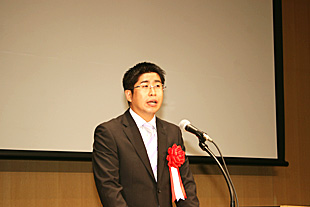 The Winner of the 10th Asia Pacific Research Prize (Iue Prize) :
The Winner of the 10th Asia Pacific Research Prize (Iue Prize) :
Dr. Masafumi Asada
Title of Dissertation :
Management History of the Chinese Eastern Railway: Russia and Manchuria, 1896–1935

- Dr. Masafumi ASADA
-
- Career -
Masafumi ASADA is a Postdoctoral Research Fellow of the Japan Society for the Promotion of Science and has conducted his research at the Graduate School of Humanity, Tokyo Metropolitan University since April 2011. He received his B.A. (2003) from the Department of History in the Faculty of Letters of Gakushuin University, M.A. (2006) and Ph.D. (2011) from the Graduate School of Letters, Hokkaido University. During enrollment at the Graduate School, he studied in Saint-Petersburg under the fellowship program for young researchers of the Japan-Russia Youth Exchange Center from July 2009 to March 2010.
- Summary -
- Management History of the Chinese Eastern Railway:
Russia and Manchuria, 1896–1935 -
The Chinese Eastern Railway (CER) provided a shortcut for the Trans-Siberian Railway across northeast China (Manchuria). This company was founded in Russia in 1896 by a contract between the Russo–Chinese Bank and the Qing dynasty and was sold by the USSR to the Japanese puppet state of "Manchuguo" in 1935. Previous Chinese and Russian studies have focused on the issues of the railway's economic influence along its line and its historical role in this region, and thus, no detailed study of the actual business conditions of the CER has been conducted so far.
This work attempts to unravel the management history of the CER by considering six topics: organization structure; income and expenditure of the railway business and analysis of goods; the trinity transportation system of the railway, steamships, and ports; the railway zone as a colony; funnel problem; and railway guards (army). In addition, this article proposes a new idea that the CER created a cross-border region that included northeast China and Russian Far East and traces the local history of northeast Asia. Moreover, the CER had associations with not only Russia but also the US, China, France, and Japan. Therefore, this article also focuses on the international history of northeast Asia.
The conclusions are as follows. First, the CER was not an ordinary stock company but a colonizing company, which was introduced to control the region and secure a geopolitical advantage. The CER was similar to the East Indian Companies that were founded by European countries. The CER's role as a colonizing company had changed in the 1920's because China had begun to retake control of the company. China dispatched its staff to the board and at times used military pressure to force the company into transferring its businesses to Chinese departments. The impatient movement, however, failed after China was defeated in the Sino–Soviet conflict in 1929. Nevertheless, the CER continued to be pressurized by "Manchuguo". The USSR decided to sell the CER because it was no more useful as a colonizing company.
The second point is the "sin and punishment" of the CER. This railway served as a base for traffic and distribution networks in northeast China and improved convenience by connecting Europe and Asia. However, one problem was that many rights were passed to Russia when the CER was constructed and the railway zone had become a Russian colony. As a result, China was forced to invest many years and much effort to recover these rights ("sin"). What was "punishment"? First, even though the railway business was profitable, its ancillary business cost put pressure on the Russian national treasury. Second, a struggle for the leadership of the CER worsened the Russo–Chinese relationship in the 1920's.
Thus, the CER had a dynamic history, which was the result of a combination of management and international politics. Hereafter the modern historical research of northeast Asia should be rewritten by including the study of the CER and develop a cross-border tendency.






